#demydiv
Explore tagged Tumblr posts
Text
Satellite imagery obtained by Bellingcat suggests that Russia created a dam on the outskirts of the occupied Ukrainian city of Tokmak in Zaporizhzhia oblast ahead of Ukraine’s counteroffensive. This was previously reported by the Center for Journalistic Investigations, which noted that the move was part of a greater trend of creating water obstacles for the Ukrainian counteroffensive. However, Planet satellite imagery seen by Bellingcat now offers a more detailed view of the scene. The Kharkiv Human Rights Protection group also noted a trend of deliberate flooding across Zaporizhzhia oblast by Russian forces.
Water has been used as a tool on several occasions since the onset of Russia’s full-scale invasion.
In these instances, dams were broken to flood downstream areas, likely in order to complicate offensive efforts of the enemy. This would lead to higher water levels and muddy ground downstream along with the longer-term outcome of dried up reservoirs.
Both sides have used these tactics so far, with Ukraine admitting to doing so in Demydiv just north of Kyiv at the start of the war. Ukraine is also reported to have blown up the floodgates of the Oskil reservoir dam in April 2022 to complicate Russian efforts. However, Russian forces are suspected of fully destroying the Oskil dam as a Ukrainian counteroffensive advanced later that year.
It now appears that Russia may be considering flooding tactics in Tokmak.
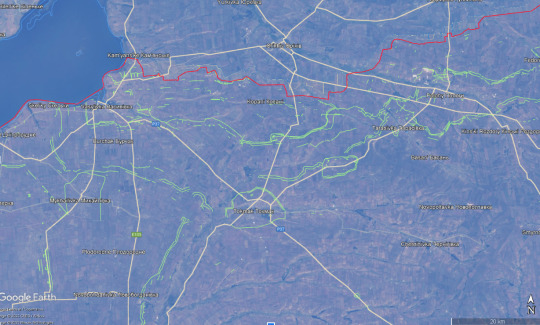
The red line represents the approximate frontline in the war while green lines represent Russian defensive lines as observed by open source researchers. Map: Google Earth, frontlines: Ukraine Control Map, defensive lines as observed by: Nathan Ruser.
The makeshift dam lies within the defensive line wrapping around the city of Tokmak, which itself is behind several more defensive lines as can be seen in the map above.
Since the dam’s construction in early May, the Tokmachka river has widened significantly to the east of the city, and flooded some fields nearest to the dam. This was visible in June 6 SkySat high-resolution imagery from Planet Labs (below), which showed that the dam was constructed out of what appears to be a sand barrier wide enough to hold back the small river. Tyre tracks leading from the dam suggest that it could also function as a second bridge, although the bridge next to it on the P37 road appears to be functioning normally.
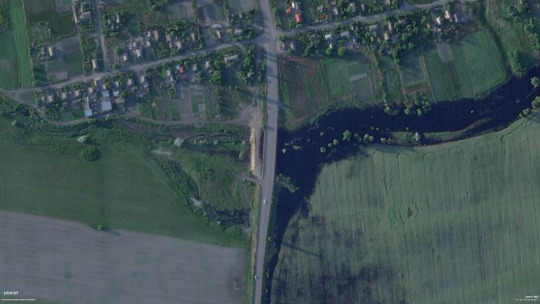
Water can be seen building up on the right of the image and spilling in to nearby fields. A yellow sand barrier can be seen to the left of the bridge in the centre of the image. Tyre tracks can be seen leading to the dam. Image courtesy: Planet Labs
Satellite imagery from Planet Labs showed tracks leading down to the site of the dam on May 3, 2023, and shows the river Tokmachka severed on May 6, with the water level on the east side of the dam steadily rising into June (as seen in the timelapse below).

Russia has spent several months preparing for the Ukrainian counteroffensive in the south of the country. The multi-layered defence is made up of several lines of minefields, anti-tank ditches, concrete obstacles, and trenches spanning the entire frontline at great depth.
Increasing the water levels of the Tokmachka river could be part of a greater effort at slowing down advancing Ukrainian forces. More specifically, this may be part of an effort to slow down an eastern envelopment of Tokmak in the event of a Ukrainian breakthrough near the city.
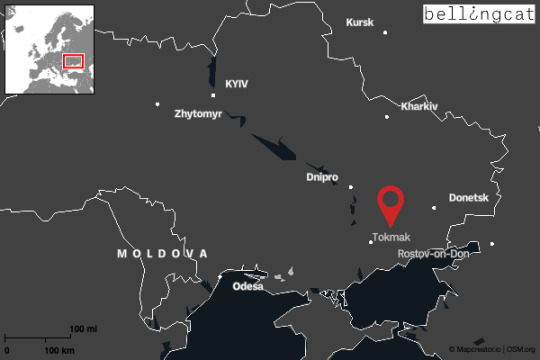
Tokmak is situated in the south east of Ukraine. Map courtesy of Map Creator.
In early June, the huge Nova Kakhovka dam in Kherson oblast broke, leading to widespread flooding and damage. The exact events leading up to the collapse of the structure remain unclear. But the New York Times reported that evidence suggested it was instigated by an inside explosion set off by Russia. Russia has denied this and Bellingcat has not been able to independently verify the New York Times’ reporting.
The damage caused by the Nova Kakhovka collapse has been immense, with CNN reporting that over 40 people are either dead or remain missing. Ukraine, meanwhile, has estimated that over one billion Euros in damage has been caused.
Given the size of the dam observed in Tokmak, however, flooding from the dam is negligible and not anywhere near the scale seen in Nova Kakhovka.
5 notes
·
View notes
Link
Ukrainian residents of Demydiv north of Kyiv flooded their village in order to stop the Russians – and it worked marvelously.
Early in the war Demydivites understood that they were all that stood between Kyiv and Russian invaders. So they used the only weapon they had – water from the river.
All around Demydiv, a village north of Kyiv, residents have been grappling with the aftermath of a severe flood, which under ordinary circumstances would have been yet another misfortune for a people under attack. This time, it was quite the opposite.
In fact, it was a tactical victory in the war against Russia. The Ukrainians flooded the village intentionally, along with a vast expanse of fields and bogs around it, creating a quagmire that thwarted a Russian tank assault on Kyiv and bought the army precious time to prepare defenses.
Most people would be unhappy about their homes being flooded. The people of Demydiv were delighted, at least with the effect they had on the war.
The residents of Demydiv paid the price in the rivers of dank green floodwater that engulfed their many of their homes. And they couldn’t be more pleased.
“Everybody understands and nobody regrets it for a moment,” said Antonina Kostuchenko, a retiree, whose living room is now a musty space with waterlines a foot or so up the walls.
“We saved Kyiv!” she said with pride.
Demydiv is still drying out almost two months after the intentional flood. But residents are able to put things in perspective.
“Fifty flooded houses isn’t a big loss,” said Volodymyr Artemchuk, a volunteer who was helping fuel the pumps now draining the village.
The flooding that blocked the northern rim of Kyiv on the west bank of the Dnipro River played a pivotal role in the fighting in March, as Ukrainian forces repelled Russian attempts to surround Kyiv and eventually drove the Russians into retreat.
A big win is a big win, even if it meant messing with a dam rather than sinking a flagship or shooting down advanced warplanes. The incident gave Demydivites an opportunity to display the Ukrainian sense of humor.
Ms. Kostuchenko, the retiree, apologized for the heaps of towels strewn on the floor as she displayed the damage to her house. “I’m sorry it’s so messy,” she said.
She sighed, lamenting that her garden, now a shallow pond, was unlikely to be planted this year. But then she joked that perhaps she would try growing rice.
Apparently the flood blocked the P02 highway which was a direct route into Kyiv. It turned the surrounding area into a quagmire. Quagmires aren’t good for tanks and most military vehicles.
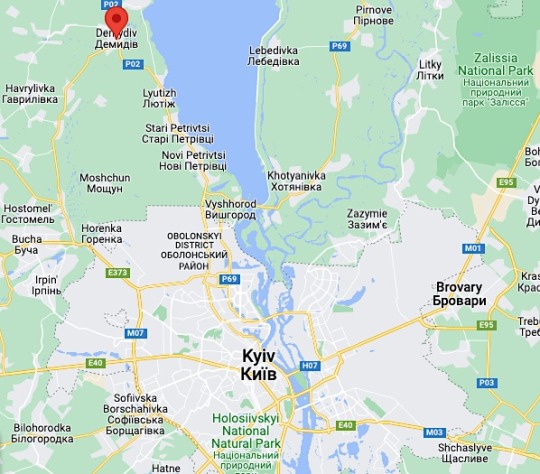
Here are before (February 26th) and after (March 18th) images.

The image on the right was taken three weeks after the initial flooding. Some of the water had probably already receded.
#invasion of ukraine#stop russia#demydiv#kyiv#intentional flooding#dnipro river#antonina kostuchenko#volodymyr artemchuk#київ#україна#вода#демидів#затоплення#антоніна костученко#володимир артемчук#Руки прочь от Украины!#нет войне#путин хуйло
6 notes
·
View notes
Link
2 notes
·
View notes
Text
Ukrainian forces flooded village of Demydiv to hamper Russian advance on Kyiv
Ukrainian forces flooded village of Demydiv to hamper Russian advance on Kyiv
Ukrainian forces flooded village of Demydiv to hamper Russian advance on Kyiv Military analysts are still debating why Russian forces failed to seize the Ukrainian capital at the start of the war more than two months ago. While the full response to that question is complex, one tactic that clearly did aid Ukrainian forces was self-sabotage. The Ukrainian army blew up key bridges and roads near…
View On WordPress
0 notes
Text
Updated throughout (12:15 UTC)
A few hours ago an alleged explosion blew up the Nova Kakhova dam in Ukraine.
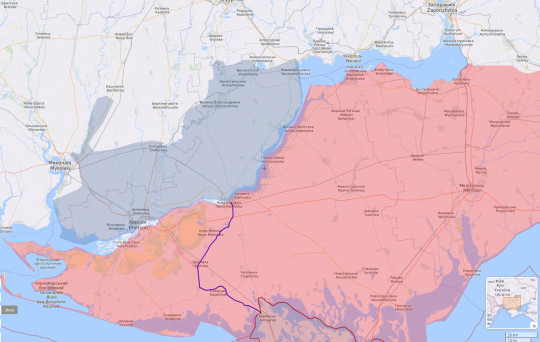
It was either that or structural damage from previous strikes.
Geoff Brumfiel @gbrumfiel - 6:31 UTC · Jun 6, 2023 The dam was already under enormous strain and damaged. Then things got worse. On 2 June, it looks like a road over the dam failed. That could be indicative of a larger structural failure. ...
In consequence the huge reservoir behind the dam is now flooding lower level land south of Kherson (Xepcoh). The pictures show the before and after of potential flooding due to the breach:


Previously the Russian army had pulled back its troops from the northern part of Kherson oblast because a dam breach would endanger their supply route.
We do not know yet how much of the dam has been damaged. How much water will be flowing out of it depends on the part of the wall that is still standing below the current water level.
Of note is that the Ukraine had previously filled the upstream dams on the Dnieper to the brim to increase the potential damage. Those waters were released in early May. Notice the date of the following tweet.
ZOKA @200_zoka - 14:12 UTC · May 4, 2023 Water level in Kakhovka reservoir in Zaporozhye region risen by 17 m and almost reached critical level. Under threat of destruction of dam in Kamenka Dneprovskaya, dozens of villages may be flooded. Kyiv opened the floodgates in Dnepropetrovsk and Zaporozhye. Embedded video
The Ukrainian propagandists are claiming that the Russian blew up the dam. That is however unlikely.
On October 21 2022 Vasily Nebenzya, the Permanent Representative of Russia to the UN, sent a letter to the UN Secretary General about the plans of the Kiev regime to destroy the Kakhovskaya hydroelectric power station.
In a report about last years Kherson counteroffensive the Washington Post reported of Ukrainian plans and attempts to blow up the dam:
[Maj. Gen. Andriy] Kovalchuk considered flooding the river. The Ukrainians, he said, even conducted a test strike with a HIMARS launcher on one of the floodgates at the Nova Kakhovka dam, making three holes in the metal to see if the Dnieper’s water could be raised enough to stymie Russian crossings but not flood nearby villages. The test was a success, Kovalchuk said, but the step remained a last resort. He held off.
Destroying its own infrastructure is nothing new for Ukrainian servicemen. In April 2022 the New York Times already noted this:
What happened in Demydiv was not an outlier. Since the war’s early days, Ukraine has been swift and effective in wreaking havoc on its own territory, often by destroying infrastructure, as a way to foil a Russian army with superior numbers and weaponry. Demydiv was flooded when troops opened a nearby dam and sent water surging into the countryside. Elsewhere in Ukraine, the military has, without hesitation, blown up bridges, bombed roads and disabled rail lines and airports. The goal has been to slow Russian advances, channel enemy troops into traps and force tank columns onto less favorable terrain.
Quoting the above Washington Post piece Andrew Korybko points to a possible motive for today's demolishing of the dam:
[Kovalchuk's] remark about how “the step remained a last resort” is pertinent to recall at present considering that the first phase of Kiev’s NATO-backed counteroffensive completely failed on Monday according to the Russian Ministry of Defense. Just like Ukraine launched its proxy invasion of Russia in late May to distract from its loss in the Battle of Artyomovsk, so too might does it seem to have gone through with Kovalchuk’s planned war crime to distract from this most recent embarrassment as well.
The most recent embarrassment was the failure of yesterday's attack near Novodarovka and Levadnoye. As the Russian Ministry of Defense noted in a special statement:
As a result of active and self-sacrificing actions of the Vostok Group of Forces, which displayed courage and heroism, the enemy has been stopped, and the set tasks haven’t been achieved. The AFU formations and military units suffered significant losses. Total AFU losses in South Donetsk direction were over 1,500 Ukrainian servicemen, 28 tanks, including FRG-manufactured 8 Leopard tanks, three French-manufactured AMX-10 wheeled tanks, and 109 armoured fighting vehicles.
(I have seen pictures of the destroyed AMX-10 reconnaissance tanks but not yet of any destroyed Leopard.)
Interestingly the 'western' media, pressed into compliance by the Ukrainian government, were thanked for their pro-Ukrainian reporting on the issue around the time the dam was breached:
Michael Tracey @mtracey - 9:42 UTC · Jun 6, 2023 Top advisor of Zelensky thanks journalists in advance today for helping the Ukraine government win the "diplomatic and informational battle" around the bombing of the Nova Kakhovka dam. Helpful reminder of the state imperatives these journalists are expected to abide by Image
The attached image of the top advisor's Telegram post has a 3:03 timestamp.
The destruction of the dam is certainly not to Russia's favor. As the 'western' aligned Moscow Times noted six months ago (link corrected):
In a catastrophic scenario, destroying the dam could send a highly destructive flood wave down the Dnipro River, causing severe flooding in large areas of southern Ukraine. Backswell would also likely flood the Inhulets River, a tributary of the Dnipro. However, terrain levels mean the flooding would likely be worse on the Russian-held left bank of the Dnipro, making a detonation of explosives on the dam an unlikely move for Moscow. "[Destroying the dam] would mean Russia essentially blowing its own foot off,” military analyst Michael Kofman said on the War on the Rocks podcast last month. “[It] would flood the Russian-controlled part of Kherson [region]… much more than the western part that Ukrainians are likely to liberate." And the secondary effects of blowing the dam could be just as severe for Russia. Lowering the river level behind the dam threatens both water supplies to Moscow-annexed Crimea and risks cutting off access to cooling water for the Russian-controlled nuclear power plant in Ukraine’s Zaporizhzhia region.
Water from the dam was also used to irrigate the southern Kherson oblast. The lack of water will disable the power generation at the dam which supplied the south.
The flood is likely to dissipate in a week or two but that does not change the major damages to the parts that Russia claims as its own.
The water will then have destroyed Russian mine fields on the left bank (seen from the spring) of the river. This will open routes for Ukrainian troops to cross the river and to attack into the southern Kherson oblast towards Crimea. There have previously reports that the Ukraine received bridging and ferry equipment for exactly this purpose.
Posted by b on June 6, 2023 at 8:24 UTC
4 notes
·
View notes
Text
D+19 and D+20 update (March 15th-16th)
google docs
Sitrep: Maneuver
Kiev AOO:
Combat continues all along the frontline west and north-west of Kiev itself, right up to the Belorussian border. The recently released video of Ukrainian artillery strikes on (either a command post or forward supply dump) has been geolocated to a point not twenty kilometers south of the Belorussian border, near the town of Poliske, which the UMoD has previously cited as the furthest western extent of Russian advance in that area. Incredibly this truck park and/or command post is scarcely two hundred and thirty meters away from the P02 highway that runs south from Belarus and to the traffic circle crossroads at Ivankiv. That it came under artillery attack indicates the Russians have not been pushing their front line further west to provide more strategic depth. While not pushing as far as Malyn to open up an additional highway is one thing, not at least securing the flank of a main line of communication along its entire length, leaving it open to artillery interdiction... what even the fuck? (PS it’s still burning.)

It seems Bucha is at least contested yet again. This video of apparently abandoned VDV armor has been geolocated to Bucha. The vehicles aren’t damaged, but it taxes imagination to suppose that Russian crews would allow random civilians to videotape their precise locations, given how accurate Ukrainian artillery has proven. Perhaps they’re simply storing the vehicles there, using civilians as human shields against their own countrymen, but I guaran-fucking-tee every tank would have sugar in the gas tank by the time they got back, if the locals didn’t just douse them with gasoline and light them up. Shit, hop in, fire them up, see if the turreted guns work. Russia’s continued inability to decisively hold even the suburbs of Kiev calls into serious doubt their ability to even push into Kiev proper before the heat death of the universe.
This video from a Russian convoy shows the Ivankiv traffic circle is still a graveyard for Russian vehicles. Given recent Ukrainian pushes northward from Kiev up to Demydiv, it’s very conceivable they’ve brought the crossroads into long artillery range (30km, for MLRS.) The distinctive decoration in the middle of the circle is hereby dubbed the “egg of death.” This is at least the third confirmed time that Russian forces have eaten shit in this roundabout.
Evidence of Ukrainian advances west of Makariv – this Russian video of a laser-guided artillery strike on two Ukrainian BMPs has been geolocated to 50.5609492, 29.6365587, 17km north-west of Makariv. Of course, given this is a Russian propaganda release we have no way of knowing the likely date of the video, but local (to me) journalists are reporting persistent rumors of Ukrainian advances this far west on the 16th and it matches previous evidence of recent fighting in Makariv. The Russians released their video on the 15th; scouting on the 15th would have preceded any Ukrainian advance on the 16th.
It was noted there were only a few bridges in the Ivankiv area that allowed passage south past a local river. It seems the Ukrianians were proactive in destroying it as a recently spotted pontoon bridge has been geolocated to near the area (51.03762, 30.12761). Incidentally, if Ukrainian forces can push north from Demydiv to within 12km of Andriyivka, this bridge will be in MLRS range, and if they push to a few km of the city, it’ll be in 152mm range.
Recent evidence of combat in the Chernihiv area – at the village of Yahidne, a highway crossroads/exchange 13km south of the city itself, at Stara Basan, 31km east-northeast of Kiev’s eastern suburb of Brovary and another field fire-damaged about 16km east-northeast of that. These are near Novyi Bykiv, where a brilliant combined-arms DEAD engagement by Ukrainian forces was recently seen (more on this later.) This indicates Russian forces are at least within 152mm range of this town; a solid 60km east of Brovary. They’re either pushing east from Kiev, north from the defensive lines that sprang up to resist the Russian drive from Sumy, or both.
See also this geolocated data of fields 16km northwest of Ivankiv (51.041111, 29.734972) showing vehicle tracks closely correlated with shell craters. This was taken on the 12 so doesn’t necessarily indicate where Ukrainian positions are now, but is further evidence that someone is pretty consistently punishing vehicular movement with accurate artillery fire, and I think we all know who that is at this point.
In general, information from this area is scarce and circumstantial, but given the trends of the last few days it seems Ukrainian counterattacks are steadily pushing the enemy back from Kiev and Chernihiv in multiple directions. At the very least they are actively contesting the areas around the city. Russians are not struggling to break into the city, they’re struggling to keep hold of the staging areas around the city. It is unclear how they can build the momentum to reverse this trend, much less generate the operational momentum required to start fighting into the city proper.
Donbas/South-Eastern AOO
UMoD claims that Russian forces have tried to encircle/bypass Izum and a (relative) wealth of geolocated images of strikes/fighting seems to confirm intense combat in that area:
This artillery strike posted by a Ukrainian artillery unit to their page on a Ukrainian social media site; geolocated to 49.106362, 37.281739. This is seven kilometers south of Izum proper.
This destroyed bridge just west of Drobysheve at 49.0409045, 37.6856864.
This video from yesterday showing a Russian tank hitting an AT mine while trying to advance is from 48.11858, 37.79489 near a highway crossroads just north of the city of Donetsk. Given this area was on the frontline of the Donbas war, the mine might have been placed back then, but the drone observing the incident indicates there’s still active defenders in the area.
This also makes the Tochka-U attack on downtown Dontesk very odd, because if Ukrainians are still defending a line just outside of the city, they could easily shell the rail yard in the city without bringing artillery too close to the front line.
Another Tochka attack was just reported in Dontesk the other day; this one further east, far from any possible legitimate targets, and this one left a crater, indicating the use of a unitary blast-frag warhead. The chances of Ukraine expending such a weapon with no obvious strategic target and having it land (yet again) in the middle of the street is rather suspicious. These may well be false-flag attacks conducted with Belorussian Tochkas.
Not geolocated but reported by multiple good sources: fighting in Rubizhne continues. This was previously reported as lost to Russian forces; that this suburb west-northwest of Severodonetsk is still defended is good news. Rough look at the front line:
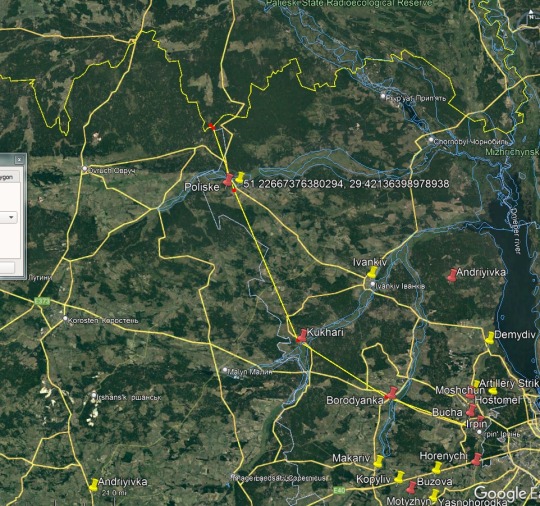
Shelling of Kharkiv continues, but no ground assaults reported in the vicinity.
According to UMoD Ukrainian forces are slowly losing ground on the southern defensive line. Taking UMoD at face value, the Finnmap seems accurate here:
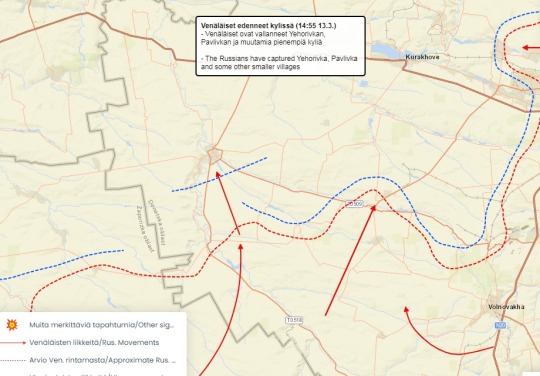
Only circumstantial supporting evidence is available but UmoD’s statement that the assault is now directed at the town of Velyka Novosilka makes sense given it’s a crossroads. Between the muddy terrain in southeastern Ukraine and the seeming failure of Russian forces to adequately adapt to conditions, they are very much road-bound; an observation the UK Ministry of Defense has echoed on their official Twitter account. Russia’s advantage in maneuver assets has been reduced even more than I expected by this, perhaps explaining their glacial rate of advance in what is otherwise open terrain that favors their artillery superiority (as well as the limited forces they seem to have committed to this theater.)
It remains to be seen if Ukraine’s forces will fight for every inch in this area to buy as much time as possible, or if they’re holding to buy time for a fallback defensive line to be entrenched. The answer may be both, as in terrain like this, against heavily mechanized forces, defense-in-depth is the favored response.
Russian units are moving deeper into Mariupol proper now. The hospital reported to have been taken is only 5km from the city center, and this widely-circulated video of a “rebel” T-64 getting lit up by multiple RPGs at once geolocates to deeper in the western part of the city (47.098538, 37.523711). This fight is far, far from over however. Russia just deliberately bombed a civilian bomb shelter that had been marked with “CHILDREN” outside of it in the city. Given the nature and quality of the units defending the city, and deliberate, shameless murders like this, I do not expect Mariupol’s defenders to surrender. A fight to the death is likely. Furthermore, Mariupol was the likely main objective of Russia’s direct attack on Ukraine in 2014; as it was the closest major city to the Donbas frontline, and sat on the main highway along the Azov coast to the Crimean peninsula; ergo it was always a mandatory target for both the Russian-puppeered “rebels” and Russian forces proper; as securing a land link to the Crimean peninsula was a major goal of Russia’s eight years of low and high intensity warfare in Ukraine. In other words the city was heavily fortified for almost a decade. These people will fight, and fight like hell. Even if Mariupol falls, the Russians are going to pay a very dear price for it; one they can scarce afford.
Kherson/Mykolaiv AOO
The biggest news is a rare detailed report of the battle of Voznesensk, the town 80km north-west of Mykolaiv along the banks of the Southern Bug river that marks the furthest west known advance of Russian forces. What seemed like a probing attack (to the best of our knowledge at the time) was apparently a brutal two-day battle that saw the Russian BTG committed to the thrust effectively destroyed as a fighting unit. The Wall Street Journal’s in-depth article is a rare in-detail look at ground facts (here is an archive.is link that bypasses their fucking paywall.) This battle reportedly took place on March 2nd and 3rd, the date when their thrust was first noted. It appears that instead of bugging out once they met stiff resistance, they went all-in trying to take the town (and its nuclear power plant) and were simply obliterated. According to the Ukrainian city officials, the Russian BTG left 30 of their 43 AFVs behind when they retreated “fifty miles” (probably to the occupied northern suburb towns of Mykolaiv.) 100ish Russian troops were reported slain; which would account for 1/3rd of a mechanized company (rendering it combat-ineffective) or easily a battalion worth of tank crews.
The entire article is worth a read. It reveals much about how the fighting is preceeding, how Russian troops are comporting themselves in general, and how Ukrainian professional soldiers, reserve militiamen and even civilians and civilian authorities worked together to defeat them. Of especial note: “Russian troops in two Ural trucks were preparing to assemble and set up 120mm mortars on the wheat field, but they got only as far as unloading the ammunition before Ukrainian shelling began.”
(Odd note – it says the municipal swimming pool was hit by a missile strike. The building reported hit in Rubizhne is also a municipal swimming pool. Whether this an extension of the terror strategy or just strikes meant to contaminate a source of relatively clean water in case a siege is required, I cannot say. Either way, Russian forces commitment to outright savage murder is hideous in the extreme.)
The other major story from this AOO is confirmation that the Ukrainians were telling the truth about their two attacks (March 6th and March 15th) on Kherson’s airport and destroying helicopters there. And not just helicopters, but supply trucks and logistical vehicles (much dispersion so revetments such artillery hardening.) Commercial satellite imagery from the 12th shows how the first attack was conducted. Note the red dots marking MLRS rocket impacts, compared to pre-strike commercial SAR imagery of where helicopters were located. To be blunt, those were not MLRS rockets. They were either either incredibly precise shooting by some Ukrainian self-propelled howitzers that did a thunder run down the road from Mykolaiv to get in range... or we have hard evidence of Ukraine’s first confirmed usage of their limited stockpile of guided 300mm MLRS rockets.
Civilian opposition is still strong in occupied Kherson. Russian occupation forces were seen searching for weapons in the city, hinting that low-intensity militia insurgency activities are still underway.
Remember this the next time some asshole tells you that you can’t fight a tank with an AR-15. It’s not tanks searching for small arms, is it?
Yet another example of rear-echelon equipment (in this case, towed guns) being captured by Ukrainian forces near Mykolaiv proper. The guns were limbered for transport and not in their revetments, implying they were abandoned simply because their prime movers (towing trucks) were hit or otherwise nonfunctional – or perhaps a Ukrainian advance came across them before they could hook them up and they fled. It’s odd that they left ammo behind as well, even if it’s only a ready pile near a firing pit. There’s no visible damage to the guns, no attempt to decommission them by shoving a thermite grenade into the breech, so it seems the Russians left in a hurry. Note the terrain; they’re nowhere near even the suburbs of Mykolaiv. It seems the Ukrainians are actively contesting the area.
See also these abandoned IFVs in rural areas, also said to be near the city.
Suffice to say that Russian efforts on the western side of the Dnieper haven’t had much success. Given these developments I think UMoD statements concerning the halting of Russian thrusts northward closer to the west bank of the Dnieper are most likely credible. Even without regular mechanized forces or tank support, one town brought not only halted a BTG, but almost completely destroyed it in detail. I doubt the Russians are having much luck elsewhere given how they are splitting their forces up so much.
That’s the big things. There’s an entire general update to go but I need to sleep for now.
11 notes
·
View notes
Text
Ukraine released water from a hydroelectric dam to block the Russian military advance, flooding the village of Demydiv.
3 notes
·
View notes
Text
Just like "Bandung Lautan Api" in Indonesia during the war.
2 notes
·
View notes
Text
6 notes
·
View notes
Photo

Demydiv, Ukraine
Visitors look at a cheetah, in a private zoo called "12 Months"
0 notes
Text
Sowohl Russland als auch die Ukraine haben bereits Dämme gesprengt
Transition News: »Bei der Frage, wer die Täter hinter der Sprengung des Kachowka-Staudamms in der Ukraine sind, könnte die Betrachtung ähnlicher Taten in der Vergangenheit hilfreich sein. In diesem Fall bringt uns das allerdings nicht weiter, denn sowohl Russland als auch die Ukraine haben seit der russischen Invasion bereits Dämme gesprengt. So hatte Reuters im Mai 2022 berichtet, dass etwa 50 Häuser im Dorf Demydiv immer noch teilweise unter Wasser stehen. Der Grund: Im Februar hatte das ukrainische Militär (...) - Konflikte / Krieg, Terrorismus, Sabotage, Corona-Transition.org, Ukraine, Russland http://dlvr.it/SqRW70 «
0 notes
Text
Meduza's The Beet: A clampdown in Kyrgyzstan
Hello, and welcome back to The Beet!
I’m Eilish Hart, the editor of this weekly email dispatch from Meduza covering Central and Eastern Europe, the Caucasus, and Central Asia. If you missed last week’s dispatch from the flooded Ukrainian village of Demydiv, you can read it on our website. For those of you still unsubscribed, that’s also where you’ll find the sign up page for The Beet.
It’s been almost two years since Sadyr Japarov rocketed from prison to Kyrgyzstan’s presidency on the heels of mass protests that forced his predecessor to step down. Since then, he has overseen sweeping constitutional changes that returned the country to a presidential system, played “catch-and-release” with his opponents, and enacted an array of new laws with little public involvement. Kyrgyzstan’s famously active civil society, meanwhile, appears increasingly worn down. As one journalist succinctly put it, Central Asia’s “island of democracy” is shrinking. So, for this week’s issue of The Beet, I teamed up with my Bishkek-based colleague Sam Breazeale (Meduza in English’s senior news editor) to cover the mounting pressure on independent journalists and civil-society activists in Kyrgyzstan.
A clampdown in Kyrgyzstan
By Eilish Hart and Sam Breazeale
On November 23, a Bishkek court ordered the deportation of prominent Kyrgyz investigative journalist Bolot Temirov. Police took him into custody immediately and, several hours later, put him on a plane to Russia without so much as a passport. “They sent me to Moscow without documents, accompanied by two [police] officers,” Temirov later told the news outlet 24.kg. “I was interrogated by FSB border service officers, who were themselves surprised by the situation.”
A Kyrgyz citizen by birth, Temirov had his passport revoked in May. He has a Russian passport, too, but it’s back in Bishkek. Nevertheless, the border guards in Moscow managed to find his information in their database and allowed him to enter the country as a Russian citizen. He’s currently staying with family members in the city while his defense lawyers appeal the court’s decision to expel him from Kyrgyzstan.
Many, including Temirov’s lawyers, view the deportation ruling as the latest twist in a politically motivated criminal case. The journalist has been battling felony charges since January, when Kyrgyz law enforcement arrested him for alleged drug possession during a raid on his media outlet, Temirov Live. Temirov maintains that officers planted the drugs. The raid came just two days after his team published an investigation into the corrupt dealings of relatives of Kamchybek Tashiev — the head of Kyrgyzstan’s National Security Committee and a close ally of President Sadyr Japarov.

A woman at a rally against the persecution of journalists holds a banner in support of Bolot Temirov following his arrest in Bishkek on January 23, 2022.
VYACHESLAV OSELEDKO / AFP / SCANPIX / LETA
The authorities brought additional charges against Temirov in April, shortly after his outlet released an investigation into Tashiev’s sons winning government contracts. This time around, Temirov was charged with forging a military ID to obtain a Kyrgyz passport and illegally crossing the state border. Just as his trial began, the authorities annulled his Kyrgyz passport.
A lower court acquitted Temirov of two of the charges in September but convicted him of document falsification. He wasn’t penalized, however, because the statute of limitations had expired. The Bishkek City Court upheld this ruling on November 23 but also supported the prosecution’s legally dubious claim that the forgery conviction rendered Temirov’s Kyrgyz citizenship void, necessitating his deportation.
“If Kyrgyzstan had independent courts, this would not have stood,” Syinat Sultanalieva, a Central Asia researcher for Human Rights Watch, told The Beet. The day after Temirov’s deportation, Tashiev claimed that he only found out about it after the fact.
‘No news today’
Temirov’s expulsion is just the latest attack on Kyrgyzstan’s free press. On October 26, the Kyrgyz government announced that it was blocking the websites of RFE/RL’s Kyrgyz service (Radio Azattyk) for two months after the outlet refused to take down a video report about the recent border conflict between Kyrgyzstan and Tajikistan. A few days later, the Kyrgyz authorities froze Radio Azattyk’s bank accounts without warning.
In a show of solidarity, independent Kyrgyz media outlets held a three-hour news blackout on October 28, replacing their web pages with a black screen and the words: “No news today. Media under pressure in Kyrgyzstan.” “We wanted as many people as possible to pay attention to this simple and succinct message,” said Dina Maslova, the editor-in-chief of the popular independent outlet Kaktus Media.
The authorities suspended Radio Azattyk’s websites under Kyrgyzstan’s controversial law on “protection from false information.” Adopted in 2021, the legislation allows the government to shut down or block websites without a court order, solely on the basis of complaints about “false information.” “It causes constant stress, because we never know who might file a complaint or why,” Maslova told The Beet.
Kaktus also ran into problems when covering the violence on the Kyrgyzstan-Tajikistan border. “For a week or two, we received constant calls requesting either that we cover things or, more frequently, that we not cover things. And our editorial team knew that trumped-up charges could be brought against us if we went ahead and reported [on those topics],” Maslova recalled. “Each time, we had to [decide] where to take the risk.”
Meanwhile, the authorities are tinkering with more oppressive legislation. At the end of September, they proposed amendments to Kyrgyzstan’s mass-media law that would introduce burdensome registration requirements and penalize “abuses of free speech.” Experts have pointed out that the draft law is almost identical to Russia’s media law, and this isn’t the only copycat bill in the mix. In November, Kyrgyz authorities put forward two restrictive draft laws targeting non-governmental organizations, one of which bears a remarkable resemblance to a previously rejected bill modeled on Russia’s notorious “foreign agents” legislation.
According to Sultanalieva, pushback from civil-society activists is the reason Kyrgyzstan’s original “foreign agents” bill didn’t pass back in 2016. But this rhetoric has had a lasting effect. “The whole discussion about the ‘foreign agents’ draft law was accompanied by a very intense smear campaign against NGOs in general,” she explained. “It’s amazing how successful this smear campaign has been. Civil society in Kyrgyzstan really feels attacked on all sides.”
Indeed, the calls for Kyrgyzstan to adopt its own “foreign agents” law never really died out. Back in February, a group of pro-government campaigners held a press conference advocating for “foreign agent” legislation and the blacklisting of Kaktus Media, Radio Azattyk, and the independent news outlet Kloop. The next day, a handful of protesters echoing these demands gathered outside of Kaktus’s office. A similar rally calling for the closure of the same three outlets took place outside of Radio Azattyk’s office in October.
“The new media and NGO [draft] laws are repressive. Under other governments, there was also pressure on the media, but not to this degree,” said Dilbar Alimova, the founder and editor-in-chief of the media outlet PolitKlinika. “Like other media workers, we also fear for our safety,” she added. “But we won’t stop our work. We’ll continue doing it.”
‘The regime is extremely unsure’
Journalists aren’t the only targets in the Japarov administration’s new clampdown on dissent. On October 23, law enforcement raided the homes of more than 20 people (including activists, journalists, and public figures), seizing their personal property and placing them under arrest for 48 hours. Most of the detainees had one thing in common: in the weeks prior, they had spoken out against a border deal being pushed by the president that would give neighboring Uzbekistan control of the strategically located Kempir-Abad reservoir.
Though Japarov claimed Kyrgyzstan would gain more than it would lose from the agreement, the negotiating process was cloaked in secrecy. “The regime basically feels overpowered by the messaging from civil society and [officials] are extremely unsure about their own actions, especially when it comes to border delimitation with Uzbekistan,” said Erica Marat, an associate professor at National Defense University’s College of International Affairs. “They [mistakenly] thought they could do it without attracting too much attention because Japarov came to power in large part thanks to his populist messaging [about dealing] with border issues.”

Demonstrators protest against the transfer of the Kempir-Abad reservoir to Uzbekistan, in front of the parliament building in Bishkek. November 15, 2022.
IGOR KOVALENKO / EPA / SCANPIX / LETA
A Bishkek court charged the detained activists with conspiring to organize mass riots and remanded them in custody until late December. One of the defendants, Nurlan Asanbekov, who maintains that he was not involved in protests and was simply working as a repairman at an opposition politician’s house on the day of the raids, declared a hunger strike. On November 1, he was rushed from a courtroom to the hospital, prompting the authorities to transfer him to house arrest.
“Asanbekov is a single father raising a 10-year-old daughter. He also has a five-year-old daughter with cerebral palsy whom he supports financially. [His] mother is also critically ill [...]. The authorities have taken everything from him and are now taking his right to life,” activist Aisuluu Kudaiberdieva wrote on Facebook.
All of the other activists remain in custody pending trial and some have been prohibited from seeing even their relatives. Japarov and his Uzbek counterpart Shavkat Mirziyoyev signed the border deal into law on November 30.
‘At least there will be changes’
On November 25, hundreds of peaceful protesters rallied in Bishkek in support of free speech. Demonstrators called for Bolot Temirov’s return to Kyrgyzstan and the release of the detainees in the “Kempir-Abad case.”
How the authorities will respond to these demands remains to be seen. “On some things, they’re willing to take a step back if there’s enough pushback from civil society and international partners,” Sultanalieva told The Beet. Revisions to the proposed amendments to the media law, for example, are already expected due to public backlash. “Ideally, this law should be removed completely because it’s unconstitutional, but journalists haven’t managed this yet. At least there will be changes,” Alimova said.
According to Sultanalieva, the mounting pressure on independent journalists and political activists is bringing these two groups together, and joining forces could strengthen their cause. “The past two years, and especially this year, has shown the media that the much-touted media freedom is going to be gone if they aren’t standing up for their rights,” she said. “There’s definitely fatigue [and] burnout on the part of civil society, but with this renewed awareness on the part of the media community, I think there’s still a chance that [these rights] can be defended.”

Protesters hold a peaceful march in support of free speech in downtown Bishkek. November 25, 2022.
IGOR KOVALENKO / EPA / SCANPIX / LETA
“Everybody understands that the Bolot Temirov case and his expulsion from the country is going to be a litmus test,” Sultanalieva added. “The feeling is that it’s going to have a disastrous psychological effect if civil society isn’t able to fight back on this one.”
At the same time, Marat underscored that past attempts to crack down on civil society haven’t ended well for Kyrgyzstan’s leaders. “For some time, the authorities are able to shut down activists. But over time, discontent grows in society and we see mass protests [and] regime change,” she recalled. The authorities’ trampling on rights and freedoms is also likely to bring civil-society activists and the general public closer together on these issues, she said.
“The most common criticism of civil society is that they’re really just representative of larger cities, Bishkek and Osh,” Marat explained. “That said, even in rural areas, there’s the habit and culture of being able to receive free and diverse information, and being able to criticize and rally against unpopular political decisions. And when those freedoms are curtailed, that’s when tensions begin. That’s why, when Azattyk is shut down, more people start noticing that something isn’t right.”
0 notes
Video
tumblr
video appeared online of the moment when lightning struck the bridge across the Irpin River in the Demydiv village near Kyiv.
Previously, after a lightning strike, a TNT charge detonated that was set to detonate in the case of a second Russian invasion.

0 notes
Text
Russia Ukraine War Live Updates: Russia pummels eastern towns; Demydiv remains partially submerged months after dam was destroyed
Russia Ukraine War Live Updates: Russia pummels eastern towns; Demydiv remains partially submerged months after dam was destroyed
Ukraine News Live Updates: As Russia asserted progress in its goal of seizing the entirety of contested eastern Ukraine, President Vladimir Putin tried to shake European resolve to punish his country with sanctions and to keep supplying weapons that have supported Ukraine’s defence. The Russian Defense Ministry said Lyman, the second small city to fall this week, had been “completely liberated”…

View On WordPress
0 notes
Text
Ukrainian forces flooded village of Demydiv to hamper Russian advance on Kyiv
Ukrainian forces flooded village of Demydiv to hamper Russian advance on Kyiv
Issued on: 05/05/2022 – 08:07 Military analysts are still debating why Russian forces failed to seize the Ukrainian capital at the start of the war more than two months ago. While the full response to that question is complex, one tactic that clearly did aid Ukrainian forces was self-sabotage. The Ukrainian army blew up key bridges and roads near Kyiv to hamper the Russian advance. In one case,…
View On WordPress
0 notes